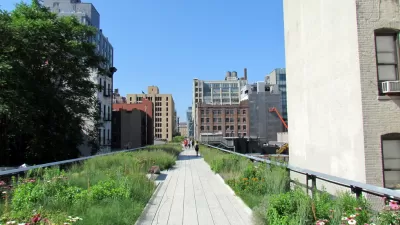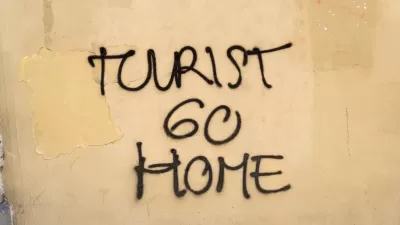It's unlikely to surprise anyone to learn that Times Square is an invaluable asset to New York City's economy, but as Patrick McGeehan points out, it has as much to do with offices as with hotels and entertainment.
A poster child of tourism as an economic engine, Times Square has drawn countless visitors to New York City for many decades. A study released this week set out to determine just how much it contributes: "one-tenth of all of the jobs in the city and $1 of every $9 of economic activity," McGeehan reports. "That amounts to $110 billion in annual economic activity – about equal to the output of Portland, Oregon," all in "an area that occupies less than 1 percent of [New York City's] land."
Tim Tompkins, president of the Times Square Alliance, which commissioned the report, attributes the success of the area to its preponderance of office space – 29 million square feet of it – and the 170,000-odd people that work there. "What's significant about Times Square is that it has become more diversified," said Tompkins. "Certainly we've become a major commercial office district... Before, we were an entertainment and hotel district."
Economist Rosemary Scanlon is quick to point out that tourism still plays a major role, enabling redevelopment nearby. Just west of Times Square, "luxury apartment towers" have sprung up "in places where no market for them previously existed," McGeehan writes.
"In the same way that we were a postcard for why not to come to New York City 20 or maybe 30 years ago," said Tompkins, "we are a powerful advertisement for how appealing the city is now."
FULL STORY: Times Square Lights Up City’s Economy, Study Finds

Study: Maui’s Plan to Convert Vacation Rentals to Long-Term Housing Could Cause Nearly $1 Billion Economic Loss
The plan would reduce visitor accommodation by 25,% resulting in 1,900 jobs lost.

North Texas Transit Leaders Tout Benefits of TOD for Growing Region
At a summit focused on transit-oriented development, policymakers discussed how North Texas’ expanded light rail system can serve as a tool for economic growth.

Why Should We Subsidize Public Transportation?
Many public transit agencies face financial stress due to rising costs, declining fare revenue, and declining subsidies. Transit advocates must provide a strong business case for increasing public transit funding.

How Community Science Connects People, Parks, and Biodiversity
Community science engages people of all backgrounds in documenting local biodiversity, strengthening connections to nature, and contributing to global efforts like the City Nature Challenge to build a more inclusive and resilient future.

Alabama: Trump Terminates Settlements for Black Communities Harmed By Raw Sewage
Trump deemed the landmark civil rights agreement “illegal DEI and environmental justice policy.”

Dear Tesla Driver: “It’s not You, It’s Him.”
Amidst a booming bumper sticker industry, one writer offers solace to those asking, “Does this car make me look fascist?”
Urban Design for Planners 1: Software Tools
This six-course series explores essential urban design concepts using open source software and equips planners with the tools they need to participate fully in the urban design process.
Planning for Universal Design
Learn the tools for implementing Universal Design in planning regulations.
City of Santa Clarita
Ascent Environmental
Institute for Housing and Urban Development Studies (IHS)
City of Grandview
Harvard GSD Executive Education
Toledo-Lucas County Plan Commissions
Salt Lake City
NYU Wagner Graduate School of Public Service





























